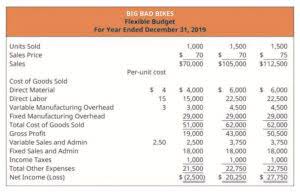
Operating Income represents what’s earned from regular business operations. In other words, it’s the profit before any non-operating income, non-operating expenses, interest, or taxes are subtracted from revenues. EBIT is a term commonly used in finance and stands for Earnings Before Interest and Taxes. However, which accounts are found on an income statement real-world companies often operate on a global scale, have diversified business segments offering a mix of products and services, and frequently get involved in mergers, acquisitions, and strategic partnerships. Perhaps the most useful financial statement, and easiest to understand, is the income statement.
- Internal users are those people who are a part of the management of the company and its board of directors, who make use of this information to analyze where the business is standing and make decisions to generate profits.
- Creditors use an income statement to see if the company has enough flow of cash to pay off the loans.
- Some of these expenses may be written off on a tax return if they meet Internal Revenue Service (IRS) guidelines.
- The Ascent is a Motley Fool service that rates and reviews essential products for your everyday money matters.
- Depreciation and amortization are non-cash expenses that are created by accountants to spread out the cost of capital assets such as Property, Plant, and Equipment (PP&E).
The statement of retained earnings indicates how much money a business has retained over a specified period of time. Creditors use an income statement to see if the company has enough flow of cash to pay off the loans. Similarly, a competitor uses income statements to know about the parameters of the business and about those areas where the business is spending extra. Operating revenue is the revenue that a company gains by performing all its primary activities, such as manufacturing products or providing services. The profits of manufacturing companies are earned by converting raw materials into finished goods by incurring labor and FOH costs. The finished goods are sold at a price including profit margin and the cost of production.
They tell you how much money you have left over
The income statement calculates the net income of a company by subtracting total expenses from total income. This calculation shows investors and creditors the overall profitability of the company as well as how efficiently the company is at generating profits from total revenues. Within an income statement, you’ll find all revenue and expense accounts for a set period. Accountants create income statements using trial balances from any two points in time.
- It also shows how well a company is using the capital of shareholders for generating revenues.
- For example, if you were to look at a trial balance on December 31, 2020, it would show the balances of all accounts on that date.
- The above example is the simplest form of income statement that any standard business can generate.
- The income statement measures a company’s financial performance over time, while the balance sheet provides a snapshot of a company’s financial position at a particular point in time.
- The „Income Statement” is a financial statement that summarizes a company’s revenues, expenses, and the resulting net income.
- They use competitors’ P&L to gauge how well other companies are doing in their space and whether or not they should enter new markets and try to compete with other companies.
This means that every year, $1,800 would be recorded as depreciation expense on the profit and loss statement of Anael Farms for the next 10 years. The gain on an income statement represents the money made by a business from unusual sources or irregular sources other than the main business activity. For example, a gain can be made by selling an old property such as a building, car, etc. Income before income tax expense is the combination of the amount of operating income and the nonoperating amounts.
Revenue Accounts in the Income Statement
Any money saved in that way will impact your income tax and interest payments—neither of which are included when calculating operating income. Likewise, some are part of overhead—the amount you pay every month just to stay in business, regardless of sales, such as rent. Other operating expenses are operating costs—they increase in tandem with the amount of sales you make. A balance sheet tells you everything your business is holding on to at a particular point in time—your assets and liabilities. The balance sheet tells you where you are, while the income statement tells you how you got there. As you can see, this example income statement is a single-step statement because it only lists expenses in one main category.

Such expenses include obsolete inventory charges or even the settlement of a lawsuit. Consider business XYZ that earned $25,000 from the sale of goods and $3,000 as revenue from training personnel. In return, the business spent money on various activities, including wages, rent, transportation, etc., leading to $14,200 in expenses. The business also gained $1,500 from the sale of an old van and incurred a $2,000 loss from a pending lawsuit. While both of these metrics denote profits made, Gains refer to profits that don’t relate to the core business of the company. They are mostly made from one-time non-business activities that might not re-occur in the future.

